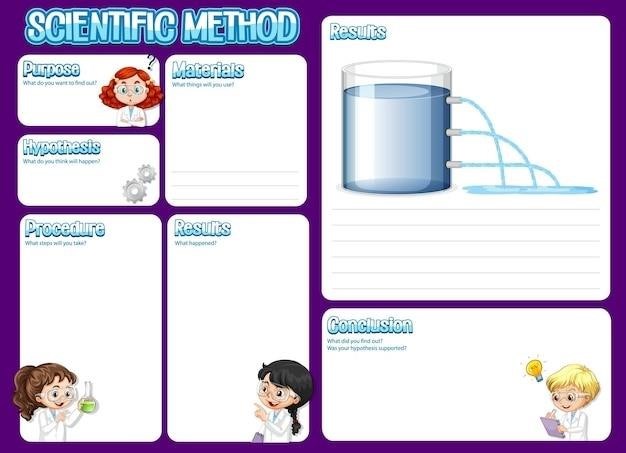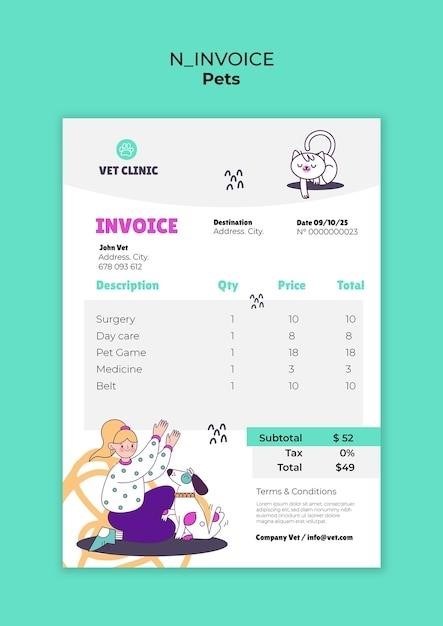PhET Reactants, Products, and Leftovers⁚ A Comprehensive Guide
This document provides directions for an activity introducing chemical reactions using an online simulation. The activity focuses on limiting reactants by using the Reactants, Products, and Leftovers simulation from PhET Interactive. The activity includes both color and grayscale files and is designed to be fun and interactive, engaging students through exploration and discovery.
Introduction to Chemical Reactions
Chemical reactions are the foundation of chemistry, representing the processes by which substances transform into new ones. These transformations involve the rearrangement of atoms and molecules, leading to the formation of new products with distinct properties. Understanding the concepts of reactants, products, and leftovers is crucial for comprehending the nature of chemical reactions and predicting their outcomes. Reactants are the starting materials that undergo a chemical change, while products are the substances formed as a result of the reaction. Leftovers, also known as excess reactants, represent the substances that remain unreacted after the reaction has reached completion.
The PhET Simulation
The PhET Interactive Simulations project, spearheaded by Nobel Laureate Carl Wieman at the University of Colorado Boulder, provides a treasure trove of free, interactive simulations for exploring various scientific concepts. Among these, the “Reactants, Products, and Leftovers” simulation stands out as an engaging tool for visualizing and understanding chemical reactions. This simulation utilizes a game-like environment, encouraging students to learn through exploration and discovery. The simulation features different levels of complexity, allowing students to gradually build their understanding of reactants, products, and leftovers.
Reactants, Products, and Leftovers⁚ The Basics
At the heart of any chemical reaction lie the reactants, the starting materials that undergo transformation. These reactants combine in specific proportions to form products, the new substances created through the reaction. However, sometimes the reactants are not present in the ideal ratio, leading to a situation where one reactant is completely consumed while another remains unused. This leftover reactant is known as the limiting reactant, as it dictates the maximum amount of product that can be formed. Understanding these fundamental concepts is crucial for grasping the essence of chemical reactions and predicting the outcome of various reactions.
Defining Reactants and Products
In the world of chemistry, reactants are the ingredients that initiate a chemical change. They are the substances that are present at the beginning of a reaction and undergo transformation to form new substances. Think of them as the building blocks of a chemical reaction. Products, on the other hand, are the substances that result from a chemical reaction. They are the new substances formed when reactants interact and undergo chemical changes. Products represent the outcome of a chemical reaction, showcasing the transformation that has occurred.

Understanding Leftovers
In chemical reactions, leftovers represent the reactants that were not fully consumed during the reaction. They are the remaining ingredients that didn’t participate in the chemical transformation. Think of leftovers as the ingredients that are left over after you’ve made a sandwich. The amount of leftovers depends on the initial quantities of reactants and the ratio in which they react. Understanding leftovers is crucial for analyzing chemical reactions, as it helps us determine the efficiency of the reaction and the limiting reactant that dictates the amount of product formed.
Exploring Chemical Reactions with the Simulation
The PhET Reactants, Products, and Leftovers simulation offers a dynamic and interactive approach to learning about chemical reactions. It features three levels of increasing complexity, allowing students to gradually progress from simple to more intricate scenarios. Level 1 introduces the core concepts of reactants, products, and leftovers through a familiar analogy of sandwich making. Level 2 dives into molecular reactions, providing a visual representation of chemical reactions at the molecular level. Level 3 takes the complexity a step further by introducing multiple reactants and products, mimicking more complex chemical reactions encountered in the real world. This progression allows students to grasp the fundamental principles of chemical reactions and develop their ability to predict the outcomes of reactions based on the initial amounts of reactants and the ratios involved.
Level 1⁚ Sandwich Making
Level 1 of the simulation introduces the core concepts of reactants, products, and leftovers through a relatable analogy of sandwich making. Students are presented with a virtual kitchen where they can choose ingredients like bread, cheese, and meat to create sandwiches. This engaging activity allows them to experiment with different combinations of ingredients, observing how the amounts of each ingredient affect the number of sandwiches they can make and the amount of leftovers. This level provides a concrete foundation for understanding the relationship between reactants, products, and leftovers in chemical reactions. Students can intuitively grasp how limited quantities of specific ingredients can prevent the creation of more products, mirroring the concept of limiting reactants in chemistry.
Level 2⁚ Molecular Reactions
Building upon the foundation established in Level 1, Level 2 delves into the realm of molecular reactions. This level introduces students to simple chemical reactions involving molecules, providing a more abstract representation of the concepts. The simulation allows students to manipulate virtual molecules, visually representing them as colorful spheres. They can combine different reactants, such as hydrogen and oxygen, to form products like water, while observing the corresponding changes in the number of molecules. Students are challenged to predict the number of product molecules and leftovers based on the initial amounts of reactants. This level reinforces the importance of stoichiometry, emphasizing the quantitative relationships between reactants and products in chemical reactions.
Level 3⁚ Advanced Reactions
Level 3 pushes the boundaries of the simulation, presenting students with more complex chemical reactions. In this level, reactions often involve multiple reactants and products, demanding a deeper understanding of stoichiometry and limiting reactants. The simulation incorporates a wider range of molecules, increasing the complexity of the reactions. Students are tasked with predicting the products and leftovers based on the initial quantities of reactants and the balanced chemical equation. This level encourages students to apply their knowledge of chemical reactions and ratios to determine the optimal combination of reactants to maximize product formation while minimizing leftover reactants. By engaging with Level 3, students develop a more comprehensive understanding of the principles underlying chemical reactions, paving the way for more advanced chemistry concepts.
Using the Simulation for Learning
The PhET Reactants, Products, and Leftovers simulation is a versatile tool for learning about chemical reactions. It provides a platform for students to actively explore the concepts of reactants, products, and leftovers in a hands-on, interactive manner. By manipulating the quantities of reactants and observing the resulting products and leftovers, students can gain a deeper understanding of the relationship between reactants, products, and limiting reactants. The simulation also offers a visual representation of chemical reactions, allowing students to visualize the transformation of reactants into products and the concept of leftover reactants. This visual approach enhances understanding and makes the learning process more engaging. The simulation is particularly valuable for students who struggle with abstract concepts, as it provides a concrete and interactive way to explore chemical reactions.
Identifying Limiting Reactants
The PhET simulation provides a fun and engaging way to explore the concept of limiting reactants; In the simulation, students are challenged to make sandwiches or molecules using different amounts of ingredients (reactants). They can experiment with various combinations of reactants to see how many products they can make. The simulation highlights the importance of the limiting reactant, which is the reactant that gets consumed first in a chemical reaction and therefore limits how much product can be formed. By experimenting with different amounts of reactants, students can observe how the limiting reactant affects the amount of product produced. This hands-on experience helps them grasp the concept of limiting reactants and its implications in chemical reactions.
Predicting Products and Leftovers
The PhET simulation allows students to practice predicting the products and leftovers of a chemical reaction. By entering the amounts of reactants in the “before” box, students can observe the resulting products and leftovers in the “after” box. This process helps students develop an understanding of the stoichiometry of chemical reactions, which involves the relationship between the quantities of reactants and products. The simulation also helps students visualize the concept of conservation of mass, as the total number of atoms remains constant throughout the reaction. Students can use this knowledge to predict the amounts of products and leftovers for different chemical reactions, even if they are not familiar with the specific reactions. This practice enhances their understanding of chemical reactions and their ability to analyze and predict the outcomes of chemical processes.
Balancing Chemical Equations
The PhET simulation provides a visual and interactive way to understand the concept of balancing chemical equations. By adjusting the coefficients in front of each molecule, students can ensure that the number of atoms of each element on the reactant side matches the number of atoms on the product side. This process helps students grasp the fundamental principle that matter cannot be created or destroyed during a chemical reaction. The simulation allows students to experiment with different combinations of coefficients and observe the resulting changes in the number of atoms, promoting a deeper understanding of the importance of balancing chemical equations. This understanding is crucial for accurately representing chemical reactions and predicting the quantities of reactants and products involved. The simulation’s game-like approach makes the learning process engaging and helps students develop a strong foundation in the core principles of chemistry.
The Value of Interactive Learning
The PhET Reactants, Products, and Leftovers simulation provides a valuable platform for interactive learning in chemistry. By engaging students in a hands-on, game-like environment, the simulation fosters deeper understanding of fundamental concepts like reactants, products, leftovers, and balancing chemical equations. The simulation’s intuitive interface and adaptable levels cater to diverse learning styles and paces, allowing students to explore at their own rhythm. By visualizing chemical reactions and manipulating molecular quantities, students develop a strong foundation in chemical stoichiometry. The simulation also promotes critical thinking and problem-solving skills as students predict outcomes and analyze results. In conclusion, the PhET Reactants, Products, and Leftovers simulation offers a powerful tool for enhancing chemistry education, making learning enjoyable, effective, and accessible for all students.
